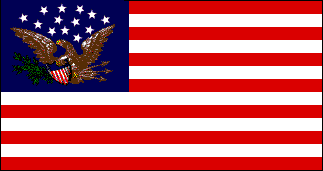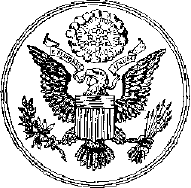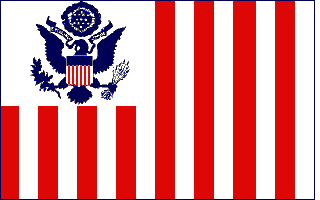The Eagle Standard

Typical Eagle Standard c.1824

In 1782, after much debate and many suggestions, the U.S. Congress adopted the Great Seal or Coat of Arms, which is still basically the same today (and which can be found on the reverse side of the one dollar bill). This design features the Bald Eagle holding a shield composed of 13 pales (vertical stripes) representing the states and a blue chief (upper third of the shield) representing Congress and, in the talons of the Eagle, a bundle of arrows and some olive branches representing the authority of Congress in matters of Peace and War.

During the Revolutionary War, Washington corresponded on many occasions with the Board of War regarding "the standard of the U. States," but it was not until 1783 that such Standards were supplied to the army. The actual design of these Standards is not explicitly stated in the correspondence but can be infered from other sources. The New York Historical Society possesses a home-spun flag that is hand sewen and features a hand-painted Eagle reputedly of Revolutionary vintage. Although this flag has no authenticated history associated with it, it is similar in its details and construction to probably date from this period.
A Silk Standard of 13 white and red stripes with an Eagle Canton is in the possession of Independence Hall in Philadelphia. It's tradition states that it was presented by Congress to General Philip John Schuyler at the close of the Revolutionary War, probably sometime shortly after 1782.
A Medal presented in 1790 to General Daniel Morgan in honor of the victory at Cowpens, in 1781, shows three Eagle Standards.
By far the most important evidence of the usage of this design by the army comes from the Society of Cincinnati, the association of Continental Officiers formed in 1783. The Society's Diploma shows an Eagle Standard held by a warrior. Later, in 1786, the Society adopted "The Standard of the Society, of silk, imitating the Standard of the United States, having thirteen blue and white stripes alternate; in the upper corner of which to be painted the bald eagle."
Other sources also show variations of this design. Charles Wilson Peale, who served as a captain in the Revolutionary War, painted many portraits during the war and some of these show this flag. Specifically, a portrait of Lieutenant Colonel Samuel Smith of the Maryland Militia (in possession of Independence Hall) and a large group portrait (now in the State House at Annapolis) showing Washington, Lafayette, and Colonel Tench Tilghman at Yorktown.
A famous drawing by J. F. Renault of the surrender at Yorktown, made sometime before 1824, shows an Eagle Flag.
After the Revolutionary War, this design became in usage a sort of government flag used to represent the soverign nature of these States. Even on ships, where the stars and stripes usually was supreme, the Eagle flag could be found on official holidays and on forts and installations representing the United States around the world. (See the painting by Jonathan Budington of the "Cannon House and Wharf" painted probably in 1812. Note the huge flag over the fort bears 17 stripes.)
Another eagle flag, still in use today, is the "ensign" of the United States Coast Guard, which was adopted in 1799 and modified in 1910 by the addition of a seal in the fly. It shows 16 vertical stripes (the correct number of states in 1799) with a white canton that has a blue eagle on it.

Eagle Flags became quite popular during the period from c. 1800 until the Civil War. Many examples can be cited: the flag used by General John Fremont, the pathfinder of the west, which subtituted a calumet or peace pipe for the olive branches so that the Indians could understand the symbolism; many of the regimental flags used in the Mexican War were Eagle Standards; during the Civil War, Northern troops frequently fought under Eagle Standards, many of which are still preserved.
It was not until 1912, actually, when the Executive Department first issued specifications detailing the exact design for United States Flags that this emblem finally fell out of use.
It is regretable that this beautiful Flag design has recieved so little attention over the last few decades. The illustration at the head of this section is not a copy of any particular flag, rather it is a reconstruction of a type of flag design that may have been used c. 1824.
Return to the US Flag History Index Page
To the Vexillology Page
To the Maine Flags Pages
To the New England Vexillological Assn. Page
To the New England Journal of Vexillology Page
To the New England Flag Page